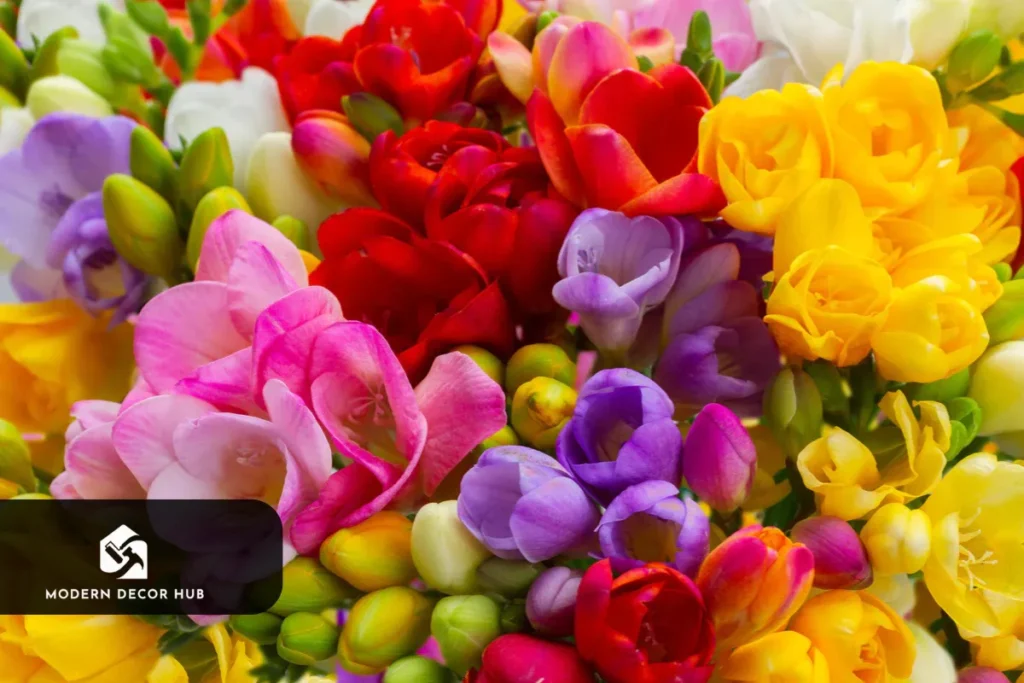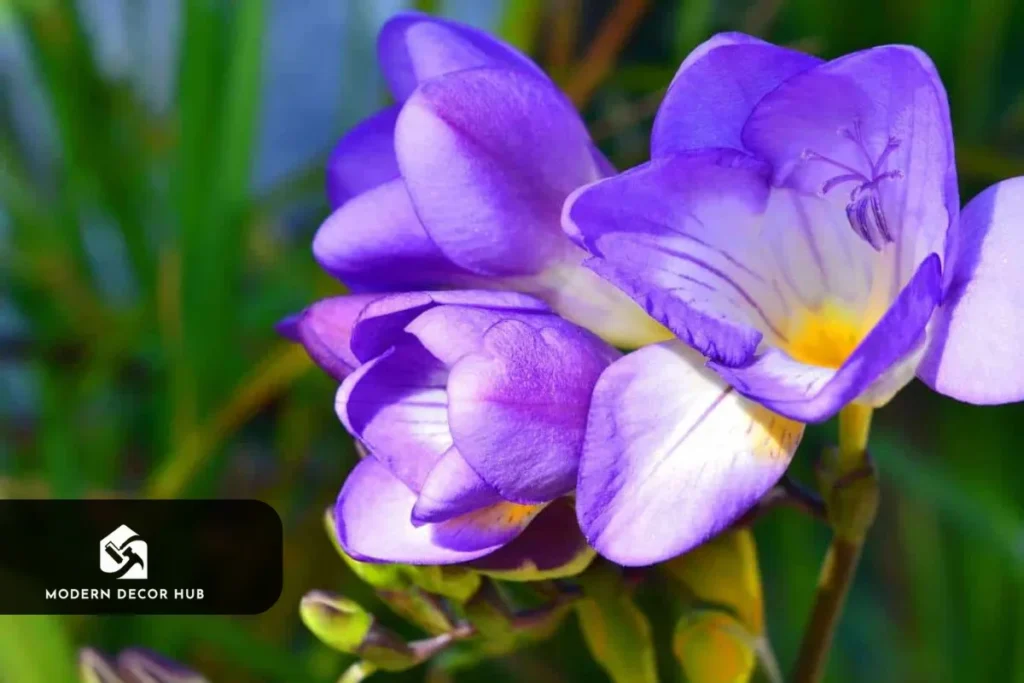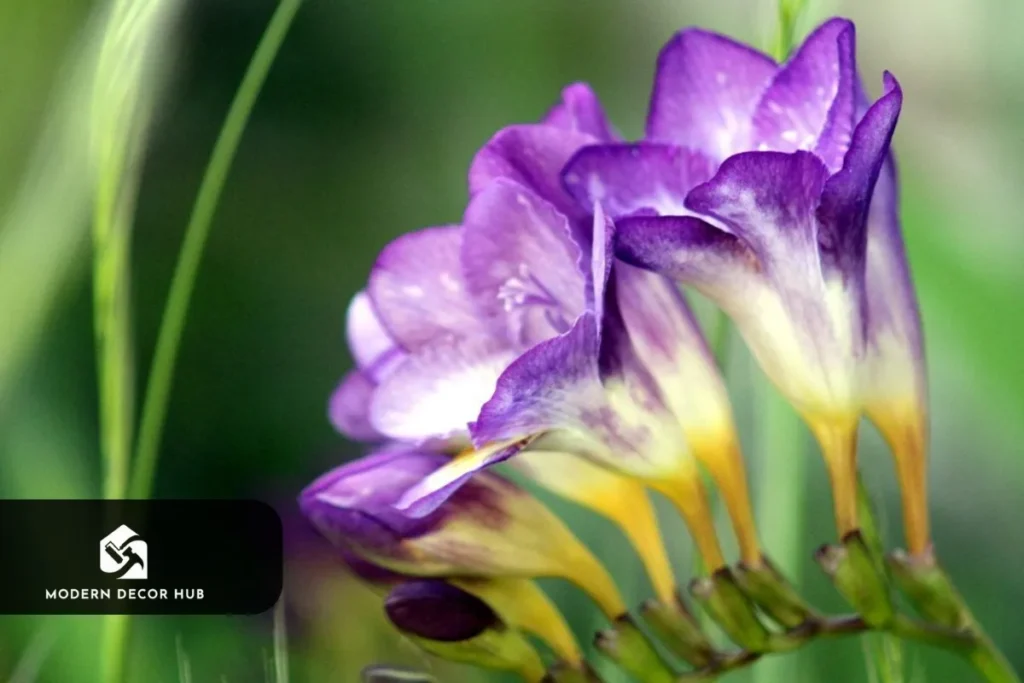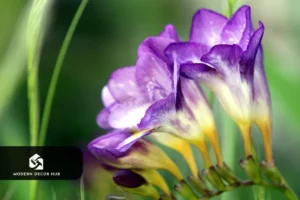Freesia is a stunning, fragrant flower that brightens any garden, bouquet, or indoor space. Known for its delicate trumpet-shaped blooms & enchanting freesia fragrance, this plant is a favorite among flower enthusiasts & gardeners alike. Whether you’re drawn to its vibrant colors, its sweet scent, or the symbolism behind it, learning how to grow & care for freesia can transform your gardening experience.
These versatile flowers can thrive both in pots & outdoor beds, making them ideal for gardeners of all skill levels. By understanding the right planting techniques, proper care routines, and how to prevent common problems, you can enjoy healthy, blooming freesias flowers year after year. This guide will walk you through everything from planting freesia bulbs to encouraging full, fragrant blooms, helping you make the most of these beautiful flowers.
Whether you want to create a freesia bouquet for decoration, explore perfumes with freesia scent, or simply enjoy their presence in your garden, this complete guide ensures you have all the tips & insights you need for thriving freesia plants.
What Do Freesias Symbolize?
Freesia flowers are more than just beautiful—they carry rich symbolism that makes them meaningful gifts & decorative choices. Traditionally, freesias represent innocence, trust, & friendship, making them a perfect flower for expressing admiration or affection. Giving someone a bouquet of freesia flowers conveys a message of purity & sincere feelings without words.
In addition to innocence, freesia is also associated with thoughtfulness & trust. This symbolism has made freesia bouquets a popular choice for weddings, baby showers, & other celebrations where genuine emotions need to be expressed. White freesias, in particular, often symbolize purity & new beginnings, while colorful varieties can express joy, creativity, & cheerfulness.
Interestingly, freesias have found their way into perfumery as well. Many fragrances, such as freesia perfume & perfume with freesia scent, aim to capture the delicate, sweet aroma of these flowers. This highlights the flower’s connection not only to visual beauty but also to sensory experiences, making it a multi-dimensional symbol of elegance & refinement.
In some cultures, freesias are given as tokens of friendship. They symbolize a bond built on honesty & loyalty, making them a thoughtful gift for friends or loved ones. The symbolic meanings are also reflected in art & literature, where freesia flowers often appear as metaphors for innocence, gentleness, & purity of heart.
Whether grown in a garden, arranged in a bouquet, or captured in a fragrance, freesias carry a universal charm. Understanding their symbolism enhances the joy of growing & gifting them, reminding gardeners & flower enthusiasts that freesia is not just a plant—it’s a meaningful gesture, a fragrant presence, & a symbol of heartfelt emotions.
What Do Freesia Plants Look Like?
Freesia plants are admired not only for their charming fragrance but also for their graceful appearance. These plants have a delicate yet vibrant look that makes them stand out in any garden, bouquet, or indoor pot. Understanding the visual characteristics of freesia is essential for proper care, aesthetic planning, & choosing the right variety for your space.
Color
One of the most striking features of freesia flowers is their wide range of colors. From pristine white freesias to deep purples, bright yellows, pinks, and even multi-colored varieties, there is a freesia for every taste & decor style. The colorful blooms are often arranged along a single stem in a cascading pattern, giving a soft, elegant appearance. Many gardeners love mixing different freesia bulbs to create a rainbow effect in flower beds or containers. The color diversity also extends to hybrids such as English pear & freesia, which offer unique shades and subtle variations in fragrance.
Plant and Bloom Length and Height
Freesia plants typically grow between 12 to 24 inches in height, depending on the variety & growing conditions. Each stem can bear multiple blooms, often ranging from 6 to 12 flowers per stalk. The blooming period usually lasts for several weeks, allowing gardeners to enjoy continuous color & fragrance. When planted in clusters, freesias flowers create a visually striking display, with blooms arranged at different heights for a layered, textured look. Proper spacing is key to ensuring that each stem has enough room to grow fully without crowding, which also helps prevent fungal diseases.
Smell
Perhaps the most enchanting aspect of freesia is its aroma. The freesia fragrance is sweet, light, and fresh, making it one of the most popular floral scents in perfumery. Many people recognize it from freesia perfume or products labeled as having a perfume with freesia scent. The fragrance is often strongest in the morning and early afternoon, subtly filling the garden or room without being overpowering. Planting multiple freesia bulbs for sale together can amplify this effect, creating a delightful sensory experience that draws pollinators like bees and butterflies while pleasing human visitors.
In summary, freesia plants are a combination of delicate beauty, vibrant colors, and enchanting fragrance. Their compact size, layered blooms, & sweet aroma make them ideal for gardens, flower arrangements, & indoor pots. Knowing what to expect in terms of color, bloom height, and smell helps gardeners choose the right freesia variety & ensures that the plants are showcased at their best, creating an inviting & visually appealing display.
Planting a Freesia Corm
Planting freesia bulbs, also called corms, is the first step toward enjoying vibrant blooms and the sweet freesia fragrance. Understanding when, how, and where to plant these corms ensures healthy growth & maximizes flowering potential.
When to Plant
Timing is crucial when planting freesia corms. These bulbs thrive when planted in late winter or early spring, after the risk of frost has passed. In milder climates, freesia bulbs can also be planted in the fall for early spring blooms. Planting at the right time allows the roots to establish before the growing season begins, ensuring strong stems & vibrant flowers. Gardeners often stagger planting times to enjoy continuous blooms over several weeks. Using freesia bulbs for sale ensures you get healthy, disease-free corms that are more likely to thrive and produce multiple blooms.
How Deep Do You Plant Freesia
Proper planting depth is essential for strong growth. Freesia corms should generally be planted 2 to 3 inches deep, with the pointed end facing upwards. Spacing is equally important—allow about 3 inches between each corm to give roots room to grow. Shallow planting can lead to weak stems, while planting too deep can delay sprouting. After placing the corms, cover them lightly with soil, water gently, and ensure the soil stays slightly moist. Using well-drained soil prevents waterlogging, which can rot the corms and stunt growth.
Additional Tips for Planting
- Soil preparation: Enrich the soil with compost or organic matter to provide nutrients for your freesia plants.
- Sunlight: Choose a location that receives bright, indirect sunlight to encourage strong stems & vibrant blooms.
- Watering: Keep soil lightly moist but avoid overwatering, especially before sprouting occurs.
- Mulching: Applying a thin layer of mulch can help retain soil moisture and regulate temperature, protecting the corms as they establish roots.
Planting freesia bulbs correctly sets the foundation for a thriving garden. Once planted, they will reward you with elegant, colorful blooms & the signature freesia fragrance that makes these flowers so beloved. Whether planted in garden beds, containers, or as part of a decorative arrangement, proper planting ensures that your freesia flowers grow strong, healthy, and fragrant throughout the season.
Freesia Care
Caring for freesia plants properly ensures they thrive, bloom beautifully, and maintain their sweet freesia fragrance. While freesias flowers are relatively easy to grow, understanding their specific needs for light, soil, water, temperature, and nutrition is key to a healthy garden display.
Light
Freesias flourish in bright, indirect sunlight. They need at least 4–6 hours of light daily to encourage strong stems & vibrant blooms. While direct sun can be tolerated, too much harsh sunlight may scorch the leaves or fade the flower colors. Indoors, placing freesia plants near a south- or west-facing window ensures they receive enough natural light. Gardeners often rotate pots or stems to ensure all sides receive adequate exposure, promoting even growth.
Soil
The ideal soil for freesia bulbs is well-draining, fertile, and slightly acidic to neutral (pH 6.0–7.0). Loose, sandy soil enriched with organic compost helps prevent waterlogging and encourages strong root development. Avoid heavy clay soil, which can trap moisture and cause the corms to rot. Adding perlite or sand to the soil mix can improve drainage, especially when planting in containers.
Water
Freesia plants require consistent moisture during their growing season but should not sit in soggy soil. Water the soil lightly whenever the top inch feels dry, ensuring the corms remain healthy and the stems remain upright. Reduce watering after flowering, as the foliage begins to yellow and die back. Proper watering supports vibrant blooms & enhances the freesia fragrance, making the plant more appealing both visually and aromatically.
Temperature and Humidity
Freesias prefer cool to moderate temperatures between 55–70°F. High temperatures may shorten the flowering period, while frost can damage the corms. These plants also thrive in moderate humidity, but too much humidity can promote fungal diseases. In cooler climates, gardeners can grow freesia plants in pots and bring them indoors during winter to maintain optimal conditions.
Fertilizer
Feeding freesia plants with a balanced, water-soluble fertilizer every 2–3 weeks during the growing season encourages strong stems, lush foliage, & abundant flowers. Fertilizers high in phosphorus help promote blooming, while nitrogen supports healthy leaf growth. Avoid over-fertilizing, as this can lead to excessive foliage at the expense of flower production. Applying fertilizer correctly ensures your freesias flowers grow healthy, colorful, and fragrant.
Types of Freesia
Freesia comes in a variety of types, each with unique characteristics in color, fragrance, and growth habits. Understanding the different freesia varieties helps gardeners choose the perfect plants for their garden, bouquet, or indoor arrangements.
Common Freesia Varieties
- Single Freesia – This classic type features elegant, trumpet-shaped blooms along a single stem. They are prized for their strong freesia fragrance and are widely used in bouquets & floral arrangements. Colors include white, yellow, pink, purple, & red.
- Double Freesia – Known for their fuller, ruffled blooms, double freesias provide a lush appearance. They are slightly less fragrant than single freesias but add impressive volume to flower displays. These are ideal for weddings or decorative arrangements where visual impact is key.
- Mini Freesia – Miniature freesia flowers are perfect for pots, small gardens, or indoor settings. Despite their smaller size, they retain the characteristic freesia fragrance and bloom beautifully when cared for properly.
- English Pear & Freesia – This hybrid combines the sweet scent of freesia with hints of English pear, often found in perfumery as freesia perfume. It’s popular both in gardens & as inspiration for fragrances due to its subtle yet captivating aroma.
- White Freesia – Symbolizing purity & innocence, white freesias flowers are often used in weddings, celebrations, and formal floral designs. They are highly fragrant and blend well with other colorful varieties in bouquets.
Choosing the Right Type
Selecting the right freesia variety depends on your purpose:
- For fragrance: Opt for single or English pear & freesia hybrids.
- For decorative impact: Choose double freesias for fuller, showy blooms.
- For compact spaces: Mini freesias or potted varieties are ideal.
- For symbolism: White freesias convey purity & elegance, perfect for meaningful gifts or ceremonies.
By knowing the types of freesia plants, gardeners can plan planting combinations that enhance color variety, fragrance, and bloom time. Planting multiple varieties together not only creates visual diversity but also extends the flowering season, ensuring your garden or indoor display remains vibrant & aromatic for weeks.
Pruning
Pruning is an essential part of freesia care that helps maintain plant health, encourages longer blooming, and promotes the growth of strong, vibrant flowers. Proper pruning techniques ensure that your freesia plants continue to produce beautiful freesias flowers year after year.
Why Prune Freesia?
Pruning removes dead, yellowing, or damaged leaves and spent blooms. This process prevents the plant from wasting energy on dying foliage and directs nutrients toward developing new stems & flowers. It also reduces the risk of diseases and keeps your freesia bulbs healthy. Regular pruning ensures that the freesia fragrance remains strong, as healthy plants produce more blooms and a richer scent.
How to Prune Freesia
- After Flowering: Once a bloom has faded, carefully cut the flower stem at the base near the corm. Avoid cutting green leaves unless they are damaged, as these leaves continue to nourish the bulb for the next season.
- Remove Dead Foliage: Trim yellow or brown leaves to prevent fungal infections and keep the plant looking tidy.
- Avoid Cutting Healthy Leaves: Leaves are essential for photosynthesis and storing energy for the next growth cycle. Cutting too many green leaves can weaken the plant and reduce flowering next season.
Tools & Tips
- Use clean, sharp scissors or pruning shears to avoid damaging the plant.
- Sterilize tools with rubbing alcohol before pruning to prevent spreading diseases.
- Dispose of pruned material properly, especially if it shows signs of pests or disease, to protect other plants in your garden.
Pruning freesia plants is simple but crucial for maintaining a thriving garden. By regularly removing spent blooms and unhealthy foliage, you encourage new growth, extend the flowering season, and ensure your freesias flowers remain vibrant, fragrant, and visually appealing. Proper pruning also supports freesia bulbs, helping them store energy efficiently for the next blooming cycle.
Propagating Freesia
Propagating freesia plants is a rewarding way to expand your garden or share beautiful freesias flowers with friends & family. Freesia propagation can be done through corm division or seeds, although corms are the most common method because they produce blooms faster and more reliably.

Propagation by Corms
Freesia bulbs, also called corms, are the easiest way to propagate new plants. Each corm can produce several offsets, which can grow into independent plants. To propagate using corms:
- Wait for Dormancy: After flowering, allow the foliage to yellow naturally and the corm to enter dormancy.
- Lift the Corms: Carefully dig up the corms from the soil once the foliage has completely died back.
- Separate Offsets: Gently separate the smaller offsets from the parent corm. Ensure each offset has roots attached.
- Store Properly: Keep the corms in a cool, dry, and dark place until the next planting season.
Planting these offsets will result in new freesia plants that bloom beautifully and carry the same vibrant freesia fragrance as the parent plant.
Propagation by Seeds
Although less common, freesia seeds can also be used to propagate plants. Seed propagation takes longer, with blooms appearing 2–3 years after planting, but it allows for experimentation with colors & hybrids. To propagate by seeds:
- Sow seeds in well-draining, fertile soil.
- Keep the soil slightly moist and provide indirect sunlight.
- Maintain a temperature between 60–70°F to encourage germination.
- Transplant seedlings carefully once they develop strong roots and leaves.
Tips for Successful Propagation
- Use healthy parent plants to ensure strong offsets or seeds.
- Avoid overcrowding; give each freesia plant enough space for roots to develop.
- Handle corms gently to prevent damage, as bruised corms may rot or fail to sprout.
- Label propagated plants with their variety, especially if you are growing multiple freesia types, to track color, fragrance, & bloom patterns.
Propagating freesia ensures a continuous supply of fragrant, colorful blooms for your garden or home. By mastering corm division or experimenting with seeds, gardeners can enjoy healthy freesia plants year after year, expanding their floral displays with minimal effort.
Potting and Repotting Freesia
Growing freesia plants in pots allows gardeners to enjoy their vibrant blooms & sweet freesia fragrance indoors or in areas with limited garden space. Proper potting & repotting techniques ensure healthy growth, strong stems, and extended flowering periods.
Choosing the Right Pot
When selecting a pot for freesia bulbs, choose one with drainage holes to prevent waterlogging, which can rot the corms. A pot that is at least 6–8 inches deep provides enough space for root growth and supports the plant’s upright stems. Consider using terracotta or ceramic pots, as they offer good airflow & help regulate soil moisture.
Potting Freesia
- Soil Preparation: Use a well-draining soil mix enriched with compost or organic matter. Adding sand or perlite improves drainage, essential for healthy freesia plants.
- Planting Depth: Place freesia bulbs about 2–3 inches deep with the pointed end facing up. Space multiple bulbs 3 inches apart to allow adequate growth.
- Watering: Water lightly after planting to settle the soil, keeping it moist but not soggy.
Repotting Freesia
Repotting is necessary when plants outgrow their container or after several growing cycles. It also helps refresh the soil and remove any corms that may have deteriorated. Steps for repotting:
- Lift the Corms: Gently remove the bulbs from the old pot after the foliage has died back.
- Clean and Inspect: Remove any damaged or rotting corms and discard unhealthy ones.
- Prepare Fresh Soil: Use a nutrient-rich, well-draining potting mix.
- Replant: Place the corms at the proper depth in the new pot, water lightly, and position the pot in bright, indirect sunlight.
Tips for Healthy Potted Freesia
- Rotate the pot occasionally to ensure even sunlight exposure.
- Avoid overwatering, as excess moisture can cause root rot.
- Fertilize every 2–3 weeks during the growing season to encourage blooms.
- Monitor for pests and diseases, as container-grown plants are more prone to infestations.
Potting and repotting freesia plants correctly ensures they remain healthy, vibrant, and fragrant. Whether grown indoors or outdoors, potted freesias flowers can thrive with proper care, giving gardeners the joy of colorful blooms and delightful scents in any setting.
Overwintering
Freesia plants are tender perennials that may not survive cold winter temperatures, especially in regions with frost. Overwintering freesia bulbs properly ensures that your plants return healthy and strong for the next growing season, providing vibrant freesias flowers and their signature freesia fragrance year after year.
Lifting the Corms
After the growing season ends and the foliage begins to yellow, carefully lift the freesia bulbs from the soil. This marks the start of the overwintering process. Handle the corms gently to avoid bruising, which can lead to rot.
Cleaning and Drying
- Shake off excess soil and rinse gently if needed.
- Inspect the corms and remove any that are damaged or diseased.
- Allow the corms to dry in a cool, dark, well-ventilated area for about a week. This drying period prevents mold growth and prepares them for storage.
Storage Conditions
- Temperature: Keep corms in a cool environment between 50–60°F. Avoid freezing temperatures.
- Container: Store corms in a breathable container like a paper bag, mesh bag, or cardboard box. Avoid sealed plastic bags, which trap moisture.
- Medium: Optional: layer corms with dry peat moss or vermiculite to maintain proper moisture balance.
Replanting in Spring
In early spring, after the risk of frost has passed, replant the stored corms in well-draining soil. Proper overwintering ensures they sprout strong, healthy shoots and bloom with vibrant colors. For indoor potted freesia plants, corms can be kept inside during winter and placed in sunlight as new growth emerges.
Tips for Success
- Label corms by variety, especially if you have multiple freesia types, to track bloom characteristics.
- Avoid overwatering during storage; corms should remain slightly dry until planted.
- Monitor for signs of mold or rot periodically and discard affected corms.
Overwintering freesia plants correctly allows gardeners to enjoy a consistent supply of fragrant, colorful blooms each year. With careful lifting, drying, and storage, your freesia flowers will return healthy and ready to brighten your garden or home.
Common Pests & Plant Diseases
Even though freesia plants are relatively hardy, they are susceptible to certain pests & diseases that can affect growth, blooms, and the signature freesia fragrance. Understanding common issues helps gardeners prevent damage and maintain healthy freesias flowers.
Common Pests
- Aphids: These small, soft-bodied insects feed on plant sap, causing distorted leaves & weakened stems. They can also spread viruses. Treat infestations with insecticidal soap or neem oil.
- Thrips: Tiny, slender insects that suck sap from blooms & foliage, leading to silvering or streaking on leaves and flowers. Regular inspection & insecticidal sprays help control thrips.
- Spider Mites: These pests thrive in dry conditions and cause yellowing leaves with tiny webbing. Increasing humidity & using miticides can protect freesia plants.
- Slugs & Snails: They feed on leaves & flowers, leaving holes and damage. Handpicking or using organic slug repellents is effective for prevention.
Common Diseases
- Fungal Diseases: Overwatering or poor drainage can cause fungal infections like botrytis blight, leading to gray mold on flowers & leaves. Ensure well-draining soil and adequate spacing to reduce humidity around plants.
- Corm Rot: Excess moisture or infected soil can rot freesia bulbs, preventing them from sprouting. Remove affected corms and improve soil drainage.
- Leaf Spot: Dark or yellow spots may indicate fungal or bacterial infections. Remove affected leaves & treat with appropriate fungicides.
Prevention Tips
- Use healthy freesia bulbs from reputable sources to reduce disease risk.
- Maintain proper spacing for airflow between plants.
- Avoid overhead watering, which encourages fungal growth.
- Regularly inspect plants for early signs of pests or disease.
By staying vigilant and taking preventive measures, gardeners can keep freesia plants healthy, vibrant, and fragrant. Prompt treatment of pests & diseases ensures your freesias flowers thrive, producing strong blooms and maintaining the beauty and scent that make them so beloved.
How to Get Freesia to Bloom
Getting freesia plants to bloom successfully requires attention to their growth cycle, proper care, and ideal environmental conditions. With the right techniques, you can enjoy vibrant freesias flowers with their characteristic freesia fragrance throughout the growing season.

Provide Adequate Light
Freesias need bright, indirect sunlight for at least 4–6 hours daily to encourage flowering. Insufficient light can result in weak stems and fewer blooms. Gardeners growing freesia plants indoors should place them near a sunny window or supplement with grow lights if natural sunlight is limited.
Maintain Proper Temperature
These plants thrive in cool temperatures, ideally between 55–70°F. High heat can reduce bloom production, while frost can damage bulbs. For regions with cold winters, indoor overwintering or greenhouse planting ensures that freesia bulbs remain protected and ready to bloom.
Soil and Water Management
Plant freesia bulbs in well-draining soil enriched with compost or organic matter. Keep the soil evenly moist during the growing season but avoid waterlogging, which can cause corm rot and reduce flowering. Proper watering ensures strong stems and supports the production of vibrant, fragrant blooms.
Fertilization
Regular feeding with a balanced, water-soluble fertilizer encourages healthy growth & flowering. Fertilizers high in phosphorus are particularly effective for promoting blooms. Apply every 2–3 weeks during active growth for best results. Over-fertilizing with nitrogen can result in lush foliage but fewer flowers.
Support & Care
Tall freesia plants may require staking to prevent stems from bending or breaking under the weight of blooms. Additionally, removing spent flowers (deadheading) directs the plant’s energy toward new blooms rather than seed production.
Timing and Patience
Patience is key when encouraging freesia plants to bloom. Depending on the variety and planting season, blooms may appear 10–12 weeks after planting freesia bulbs. Staggering planting times can provide a continuous display of freesias flowers, ensuring your garden or indoor arrangement stays colorful and fragrant for weeks.
By carefully managing light, temperature, soil, water, and nutrition, gardeners can maximize bloom production and enjoy a long-lasting display of freesia flowers. With proper care, your freesia plants will reward you with vibrant, fragrant, and elegant flowers year after year.
Common Problems with Freesia
Even with proper care, freesia plants can encounter problems that affect their growth, bloom quality, and overall health. Recognizing common issues early allows gardeners to take corrective action and maintain vibrant freesias flowers.
Yellowing Leaves
Yellow leaves on freesia plants often indicate overwatering, nutrient deficiency, or natural dormancy. Overwatering can suffocate roots, causing them to rot, while a lack of essential nutrients, especially nitrogen, can prevent healthy leaf growth. Sometimes, older leaves naturally yellow as the plant focuses energy on flowering. To address yellowing:
- Adjust watering frequency to keep soil slightly moist but not soggy.
- Apply a balanced fertilizer to replenish nutrients.
- Remove severely yellowed leaves to maintain plant health and appearance.
Dark Spots
Dark spots on freesia leaves or stems are typically caused by fungal or bacterial infections. Overcrowding, poor air circulation, and excess moisture increase the risk of these infections. Dark spots can weaken plants and reduce bloom quality. Treatment includes:
- Removing affected leaves immediately.
- Ensuring proper spacing between plants for airflow.
- Applying a suitable fungicide if the infection persists.
Yellow or Green Lesions
Yellow or green lesions may indicate viral infections or pest damage. These irregular markings can stunt growth and cause distorted flowers if left untreated. To manage lesions:
- Inspect plants regularly for pests like aphids or thrips, which can transmit viruses.
- Remove infected plants to prevent spreading disease.
- Use virus-free freesia bulbs for future planting.
By monitoring your freesia plants and addressing issues promptly, you can prevent minor problems from becoming severe. Healthy care routines, proper watering, adequate light, and preventive pest control ensure that your freesias flowers remain vibrant, fragrant, and visually stunning.
Final Thought
Freesia plants are a delightful addition to any garden, patio, or indoor space, offering vibrant colors, elegant blooms, and their signature freesia fragrance. By understanding their symbolism, planting techniques, proper care, pruning, propagation, and common problems, gardeners can ensure healthy growth and abundant flowering. Whether you’re planting freesia bulbs in beds or pots, managing pests, or overwintering for next season, attention to detail makes all the difference. With patience & consistent care, your freesias flowers will thrive, bringing beauty, fragrance, and a touch of elegance to your surroundings year after year.
FAQs
What do freesias smell like?
Freesias have a sweet, light, and fresh fragrance that is highly popular in gardens & perfumes.
Can freesia grow in pots?
Yes, freesia plants thrive in pots with well-draining soil & adequate sunlight.
What month does freesia bloom?
Freesias usually bloom from late winter to spring, depending on planting time and climate.
What does freesia symbolize?
Freesias flowers symbolize innocence, trust, and friendship, making them meaningful gifts.
What does freesia mean in love?
In love, freesia represents trust, thoughtfulness, and sincere affection.
Which flower signifies beauty?
Many flowers symbolize beauty, but freesias are celebrated for their elegance, vibrant colors, and sweet fragrance.




